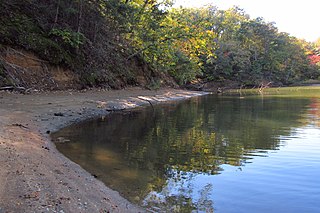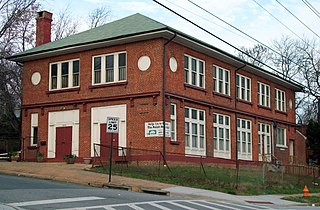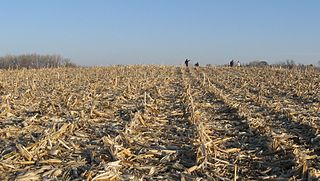Related Research Articles

The Severn River is a tidal estuary 14 miles (23 km) long, located in Anne Arundel County in the U.S. state of Maryland, south of the Magothy River and north of the South River.

Curtis Bay is a residential / commercial / industrial neighborhood in the southern portion of the City of Baltimore, Maryland, United States.

The William Paca House is an 18th-century Georgian mansion in Annapolis, Maryland, United States. Founding Father William Paca was a signatory of the Declaration of Independence and a three-term Governor of Maryland. The house was built between 1763 and 1765 and its architecture was largely designed by Paca himself. The 2-acre (8,100 m2) walled garden, which includes a two-story summer house, has been restored to its original state.
The Vanderbilt Archeological Site is an archaeological site located on the shore of Lake Oahe in Campbell County, South Dakota, near Pollock, South Dakota. The site contains the remains of a Native American Plains village which has been tentatively dated to about 1300 AD. Despite the fact that the site is subject to erosive destruction from wave action on the lake, it has been determined likely to yield significant information about the movements and living patterns of prehistoric Native Americans in the region. The site was declared a National Historic Landmark in 1997.
Walker Prehistoric Village Archeological Site is an archeological site located near Poolesville, Montgomery County, Maryland. The site is a large Late Woodland village located on Selden Island in the Potomac River. Excavations carried out in the 1930s and 1940s revealed a 40-foot section of a palisade, circular house patterns, shallow oval pits and cylindrical pits, and flexed burials interred in the floors of the houses.
Aisquith Farm E Archeological Site is an archaeological site near Riva in Anne Arundel County, Maryland. It is one of several small sites located within the confines of Aisquith farm. It is associated with the Early and Middle Woodland periods of cultural development in Anne Arundel County. The site is significant as a base camp property type.
The Beck Northeast Site is an archaeological site near Davidsonville in Anne Arundel County, Maryland. This site was discovered in the 1930s and investigations since that time have revealed artifacts dating from the Late Archaic period through the Middle Woodland period.
The Katcef Archeological Site is an archaeological site near Crofton in Anne Arundel County, Maryland. It is a series of overlapping base camp sites dating from the Clovis phase of the Paleoindian period, through to the Late Woodland period. The primary era of site utilization was during the Late Archaic period.
The Magothy Quartzite Quarry Archeological Site is an archaeological site near Pasadena in Anne Arundel County, Maryland. The site consists of several large outcroppings of quartzite and sandstone, that may have been utilized by prehistoric Native American groups as early as the Middle Archaic period, if not earlier.

The Martins Pond Archeological Site is an archaeological site near Annapolis in Anne Arundel County, Maryland. It is a Middle-Late Woodland period site, with lithic, floral, and faunal remains.
The Old Colony Cove Site is an archaeological site near Rose Haven in Anne Arundel County, Maryland. The site consists of a shell midden and is 2,000 feet (610 m) long by 300 feet (91 m) wide.
The Elkridge Site, or Elkridge Prehistoric Village Archeological Site, is an archaeological site near Elkridge in Anne Arundel County, Maryland. It is located on a 20-foot (6.1 m) terrace above the Patapsco River and extends 1,200 feet (370 m) along the river and inland from 20 to 400 feet. It is the only known Woodland period riverine-oriented village site in the tidewater Patapsco River valley which has at least partially escaped the totally destructive forces of gravel quarrying. The site appears to have been abandoned as a permanent village in the early 16th century.

Belvoir is a historic house at Crownsville, Anne Arundel County, Maryland. It is a two-story, T-shaped building, constructed of brick, stone, and wood. The home is a product of building evolution spanning the 18th, 19th, and 20th centuries. The earliest portion was probably built about 1736, but could date to the 17th century. It was the home of the grandmother of Francis Scott Key, who composed the Star Spangled Banner. Key visited in the summer in 1789.
Bristol is an unincorporated community in Anne Arundel County, Maryland, United States. Jug Bay Wetlands Sanctuary and the colonial town of Pig Point are on the Patuxent River waterfront portion of Bristol. Pig Point saw War of 1812 action and was the county's largest steamboat port on the Patuxent in the mid-19th century. Pig Point is a very significant Native American Early Archaic Period archaeological site.

Polish Home Hall is a historic building located in the waterfront industrial/commercial/residential and heavily ethnic community of Curtis Bay in southern Baltimore, Maryland,. Built on the southwest corner of Fairhaven Avenue and Filbert Street near the top of the commanding heights overlooking to the east the sloping streets of the neighborhood of Curtis Bay, about four city blocks wide and 15 blocks length.

The Umatilla Site is an archaeological site near Umatilla, Oregon, United States. Situated on the shores of the Columbia River, the prehistoric component of the site is associated with the origins of seasonal (winter) sedentism around fishing opportunities. Pit houses at Umatilla date to at least 470 BCE, and significant evidence is present of occupations earlier than the pit houses. Other remains found include stone and bone art objects, burials, and extensive animal remains. The total set of remains may represent the largest prehistoric site in Oregon by area. The site may also yield useful evidence of the historical period of the town of Umatilla, founded over the prehistoric remains in the 1860s as a gold mining supply base and relocated in 1967 in connection with the construction of the John Day Dam.
KOD-171 is a prehistoric and historic archaeological site in the vicinity of Larsen Bay, a city on the north side of Kodiak Island in southern Alaska. The site was discovered by Smithsonian Institution archaeologist Aleš Hrdlička and described in 1944 as containing both historical Russian artifacts as well as prehistoric Kachemak Bay tradition artifacts. A 1978 survey team reported the site to include 22 house pits and an eroding shell midden. The site, listed on the National Register of Historic Places in 1981, is subject to erosion and vandalism by pot hunters.

Kimball Village is an archaeological site located in the vicinity of Westfield, Iowa, United States. It is one of six known Big Sioux phase villages from the Middle Missouri tradition that existed between 1100-1250 C.E. The site, located on a terrace overlooking the Big Sioux River, has well-preserved features, including earth lodge and storage pits, and evidence of fortifaction. The site was listed on the National Register of Historic Places in 2010, and as a National Historic Landmark in 2016.

The Gordon–Schaust Site is a prehistoric Native American archaeological site in Crosslake, Minnesota, United States. It comprises two separate but nearly parallel groups of linear mounds, undated but well preserved. The site was listed on the National Register of Historic Places in 1974 for having state-level significance in the theme of archaeology.
The Rosenstock Village site is a historic site located in Frederick County, Maryland, United States, near the city of Frederick. It contains the remains of a Late Woodland Village situated on a bluff overlooking the Monocacy River. The village was occupied between A.D. 1335 and A.D. 1400, based on artifact analysis and radiocarbon dating. It is similar to the Montgomery Complex, which is a cultural complex made up of Late Woodland sites located on the Potomac River. The site was excavated in 1979 and from 1990 to 1992, and estimates suggest that 93% of the site remains undisturbed. They uncovered a large oval area surrounded by pits, a large sheet midden area, and what are believed to be two sweatlodges. The excavations have yielded a trove of artifacts and animal remains. The site was listed on the National Register of Historic Places in 2018.
References
- ↑ Federal and state laws and practices restrict general public access to information regarding the specific location of this resource. In some cases, this is to protect archeological sites from vandalism, while in other cases it is restricted at the request of the owner. See: Knoerl, John; Miller, Diane; Shrimpton, Rebecca H. (1990), Guidelines for Restricting Information about Historic and Prehistoric Resources, National Register Bulletin, National Park Service, U.S. Department of the Interior, OCLC 20706997 .
- 1 2 "National Register Information System". National Register of Historic Places . National Park Service. April 15, 2008.
- ↑ "Arundel Cove Archaeological Site". Maryland Historical Trust. Retrieved October 29, 2008.

